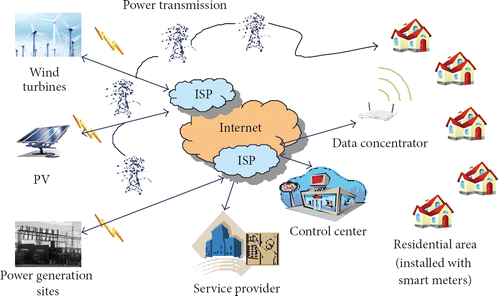Introduction
How many times have you felt guilty about excessive usage of electricity when you see your monthly bill? Imagine managing the electricity delivered to your house like you manage activities like personal banking from a computer!
You will no longer have to wait till the end of the month to know how many units you have consumed- you have “Smart meters,” and other mechanisms, will allow you to see how much electricity you use, when you use it, and its cost. It also comes with real-time pricing, which will allow you to save money by using less power when electricity is most expensive.
What is a Smart Grid?
The grid, is an electric grid which is a network of transmission lines, stations, transformers and more that deliver electricity from the power plant to your houses or establishments. When you connect any device to the switch, you are actually logging onto this grid. This grid is made ‘smart’ by establishing a two way communication between the customers and the supply, digitally. Technologies will work with the electrical grid to respond digitally to our quickly changing electric demand, at the consumer end.

How does it work?
Visualisation Technology
It will be able to explore the state of the grid at the national level and switch within seconds to explore specific details at the street level. It will provide rapid information about blackouts and power quality as well as insights into system operation for utilities. With a platform built on Google Earth, it can also take advantage of content generated by Google Earth’s user community.
Advanced Metering Infrastructure
It is based on consumer friendly efficiency concepts like ‘Prices to devices’-Assuming that energy is priced on what it costs in near real-time ,price signals are relayed to “smart” home controllers or end-consumer devices .The devices, in turn, process the information based on consumers’ wishes and power accordingly. So, the house or office responds to the occupants, rather than vice-versa. Unlike the traditional way, where technicians are sent to each consumer site monthly to record the data manually for the billing purpose, the smart meters in AMI provide real-time monitoring capability of electric loads remotely. The information on power usage can be collected periodically (e.g., every 15 minutes)
Phasor Measurement Units(PMU)
This samples voltage and current many times at a second at a given location to give instantaneous visibility into the power system.
How is it better than the existing grid?
-
It can complement the current electric grid system by including renewable energy resources, such as wind, solar, and biomass, which is environmentally cleaner as compared to the fossil fuels used in many bulk electric power generation facilities.
-
Lesser transmission loss due to decreased distance between the consumer and supply.
-
Amount of electricity consumed is intimated to the consumer periodically and hence he/she can decide to modify it and in the process save it too. The main challenge in implementing this on a larger scale ,would be the cost of rebuilding the entire electric grid, to make it smart and in the process, to handle the security issues that arise because of the networking ability of a smart grid.
References
For further reference about smart grid and its realization, visit
